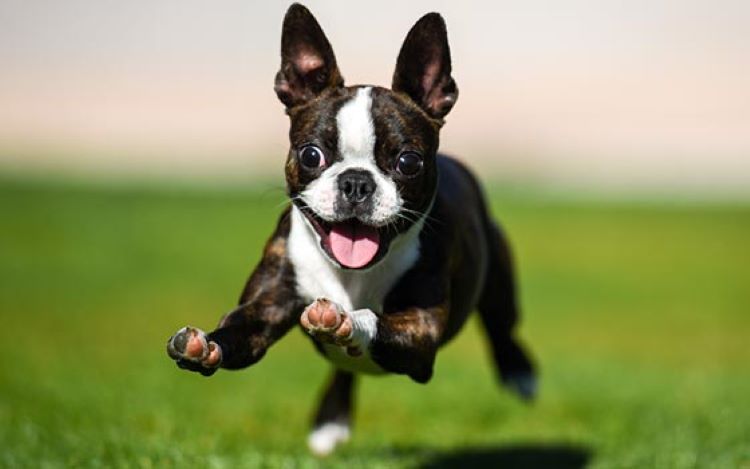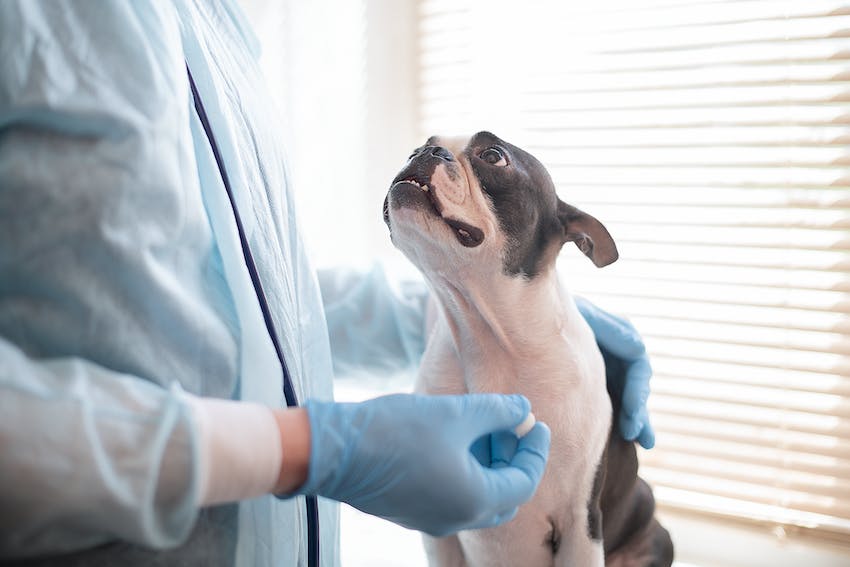Ready to help treat your pet to a healthy life?
Boston Terrier Breed Guide: History, Health & Fun Facts
By : Trupanion Staff | Updated May 2, 2024

For those familiar with the dog breed, few things bring more joy than a Boston Terrier engaging in play or cuddling up with their favorite human. Spunky and endearing with a distinctive tuxedo-like coat pattern, Bostons have captured the hearts of dog lovers worldwide. In recent decades, they have grown to be one of the most popular pets.
Whether you're considering adding a Boston Terrier to your family or simply want to learn more about these delightful little canines, this guide is here to help on all things Boston Terrier. Get ready to fall head over heels for these sprightly and charismatic pups!
7 fun facts about Boston Terriers
- The Boston Terrier is the official state dog of Massachusetts.
- This breed was the first dog breed developed in the United States. In their early days, they were lovingly referred to as “Round Heads” before the breed’s name was officially changed to Boston Terrier in 1891.
- Though considered small dogs, fully-grown Bostons actually fall into three different weight classes: under 15 lbs., 15-20 lbs., and 20-25 lbs.
- Bostons are often confused with French Bulldogs because they look so similar (due to their shared ancestry), especially as puppies. To tell the difference, look for the Boston’s distinctive white markings on their face and chest that gives them the look of wearing a tuxedo. Boston Terriers also have longer legs, a more pointed ear tip, and a rounder head than their French Bulldog cousins.
- Helen Keller owned a Boston Terrier named Sir Thomas, nicknamed “Phiz,” who was given to her by her college classmates at Radcliffe. While Sir Thomas was known to be a bit selective in who he made friends with, he reportedly took to Keller right away and they shared a special bond.
- Boston Terriers are Brachycephalic dogs, which puts them at higher risk of breathing difficulties and airway issues.
- Boston lifespans typically range between 11 and 13 years old, though this depends greatly on genetics, lifestyle, and environmental factors.
Getting to know the Boston Terrier
Bostons make great pets for a wide range of personalities and types of households. From small city apartments to sprawling rural homes, single pet owners and large families, these dogs are highly adaptable to different lifestyles.
While often considered to be black and white dogs, Boston Terriers have more variation in their appearances. They sport a short, smooth coat and come in three colors: Black, brindle, and seal — all with white on the face and chest which give them their dapper tuxedoed look. The seal color appears black, but when under bright light or sunlight has a reddish tint.
Do Boston Terriers get along with others?
While Boston Terriers are known for their outgoing and social nature, proper proactive exposure to new sights, sounds, people, dogs, and other animals as a young puppy is essential for their socialization skills.
Bostons are a frequent breed choice for families with children. They’re outgoing, rugged, and can tolerate the physical handling of young kids even though they are a smaller breed. Make sure they have been properly introduced and socialized with children as a young puppy to set them up for success. Young children and dogs should always be supervised, and it’s helpful for a dog to have their own “safe space” where they can go when they need some quiet time.
When it comes to animal buddies in the home, it’s once again, all about socialization. As long as they have been properly socialized and introduced, Boston Terriers can enjoy and benefit from the companionship of other animals.
A gentleman's personality
There’s a reason the Boston Terrier is known as the American Gentleman. Not only does this pup sport a dapper look, but they are friendly, sociable, and have a charm that evokes East Coast sophistication. Created from crossing bulldog and terrier breeds, Bostons have inherited the more mellow bulldog temperament with the athleticism terriers are known for, making for an energetic companion dog. They love to play and are always willing to be co-pilot on their human's adventures.
Similar breeds to the Boston Terrier
- French Bulldog
- Pug
- Rat Terrier
- English Bulldog
- Miniature Bull Terrier
History of the Boston Terrier
As their name suggests, the Boston Terrier breed was developed in Boston, Massachusetts. As pit fighting became less popular in England and the United States, dog fanciers began crossing bulldog and terrier breeds in an effort to create a smaller companion dog.
In 1870, a Bostonian named Robert C. Hooper bought a dog
named Judge from a friend. Judge was a cross between a Bulldog and a white English Terrier (a now extinct
breed) and became known as Hooper’s Judge. Judge was the base for the Boston Terrier breed, and all Boston
Terrier puppies can trace their lineage back to him. The breed carries on his white markings on the face and
the more even mouth compared to other bulldog breeds.
Through selective and carefully recorded breeding, the Boston Terrier breed was standardized very quickly compared to other breeds. Fanciers of the dog nicknamed them “roundheads” and formed the American Bull Terrier Club in 1889, but changed the name in 1893 after confusion between breeds with similar names to the Boston Terrier Club. That same year the breed was recognized by the American Kennel Club — the first breed created in the United States to be recognized. While their name might include terrier, they aren’t a part of the terrier breed group. In fact, they were the first breed to be included in AKC’s Non-Sporting group.
Care tips
While often considered low maintenance, Boston Terriers still require careful care to ensure their health and well-being. For example, a Boston’s coat doesn’t provide much insulation — it’s important to keep them warm in colder temperatures with a jacket or sweater.
Boston Terriers also need weekly brushing, which helps evenly distribute the natural oils in their coat and remove any dirt and shedding fur. Occasional bathing is recommended only when a Boston gets dirty or seems extra stinky. Take care to not overwash and strip the coat of its natural oils. A Boston’s face wrinkles should be kept clean and dry, to keep the yeast and bacterial populations in check and prevent uncomfortable and recurrent infections. Introduce your puppy to the grooming experience from a young age to create a positive association and encourage a calm and relaxing “spaw” treatment.
Behavior and training
Boston Terriers are bred as a perfect sidekick. As companion dogs, they have the energy to keep up on most adventures, but also enjoy just lazing around on your lap. Their temperament makes them a frequent choice for therapy dogs as long as they have been properly socialized and positively exposed to different environments as puppies. Some Bostons can become protective of their owners, so early and continued socialization throughout life is important. A Boston has ratter genes, so you might notice some instinctual predisposition for chasing squirrels and other squeaky things — this makes them ideal candidates for playing fetch or tug!

Exercise and mental enrichment needs
Boston Terriers are one of the higher energy companion dogs, but while they need consistent exercise, it
doesn’t take too much. A twice-daily walk paired with some play are usually enough to keep a Boston happy
and healthy.
Mental enrichment is important for Boston Terriers, not only to keep them entertained but also to help prevent separation anxiety. Stimulate their brains by teaching new tricks, attending obedience classes, joining a dog sport, and providing dog puzzles and interactive toys. Boston Terriers are super smart, so mixing up their toys and puzzles will keep them on their toes and always learning.
Common behavioral issues
Boston Terriers sometimes take to house training slower than other breeds, though most get the hang of it by six to nine months of age. Because Bostons love their humans so much, they are prone to separation anxiety if they aren’t taught at a young age that being away from their human is nothing to worry about. Spending some time on this potential problem early on will save you and your Boston many anxious days.
Activities the Boston Terrier enjoys
Boston Terriers do well in many different dog sports, and especially enjoy activities where they work in tandem with their human:
- Flyball
- Agility
- Therapy Work
- Rally Obedience
- Dock Diving
- Earthdog / Barnhunt
- Canine Freestyle
Boston Terrier health concerns
The Boston Terrier is a brachycephalic dog breed. Years of breeding based on appearances have resulted in the dog having a shorter-than-normal snout, which can cause breathing difficulties and lead to long-lasting health conditions. It's important to keep Boston Terriers current on their veterinary care to help catch issues early. In some cases, surgery may help improve your dog's breathing.
Even with healthy dogs, it's important to take preventative steps. Never exercise them in warmer temperatures or when it’s humid outside, and provide lots of breaks and water. Bostons, like all flat-faced breeds, should always be monitored for heat stroke symptoms, which often include: heavy panting, drooling, bright red tongue or gums, rapid pulse, and wide, panicked eyes.

Boston Terriers in Pop Culture
Friendly and spunky, Boston Terriers have long been popular in media and in the arms of celebrities.
Boston Terriers in Movies
- Georgia in Hotel for Dogs (2009)
- Nubbins in The Back-up Plan (2010)
- Winston (an adorable animated pup!) in the Disney short, Feast (2014)
- Bug (voiced by Jaime Foxx) in Strays (2023)
Famous owners (past and present) of the Boston Terrier
- Rose McGowan (Actress)
- LeAnn Rimes and Eddie Cibrian (Singer, Actor)
